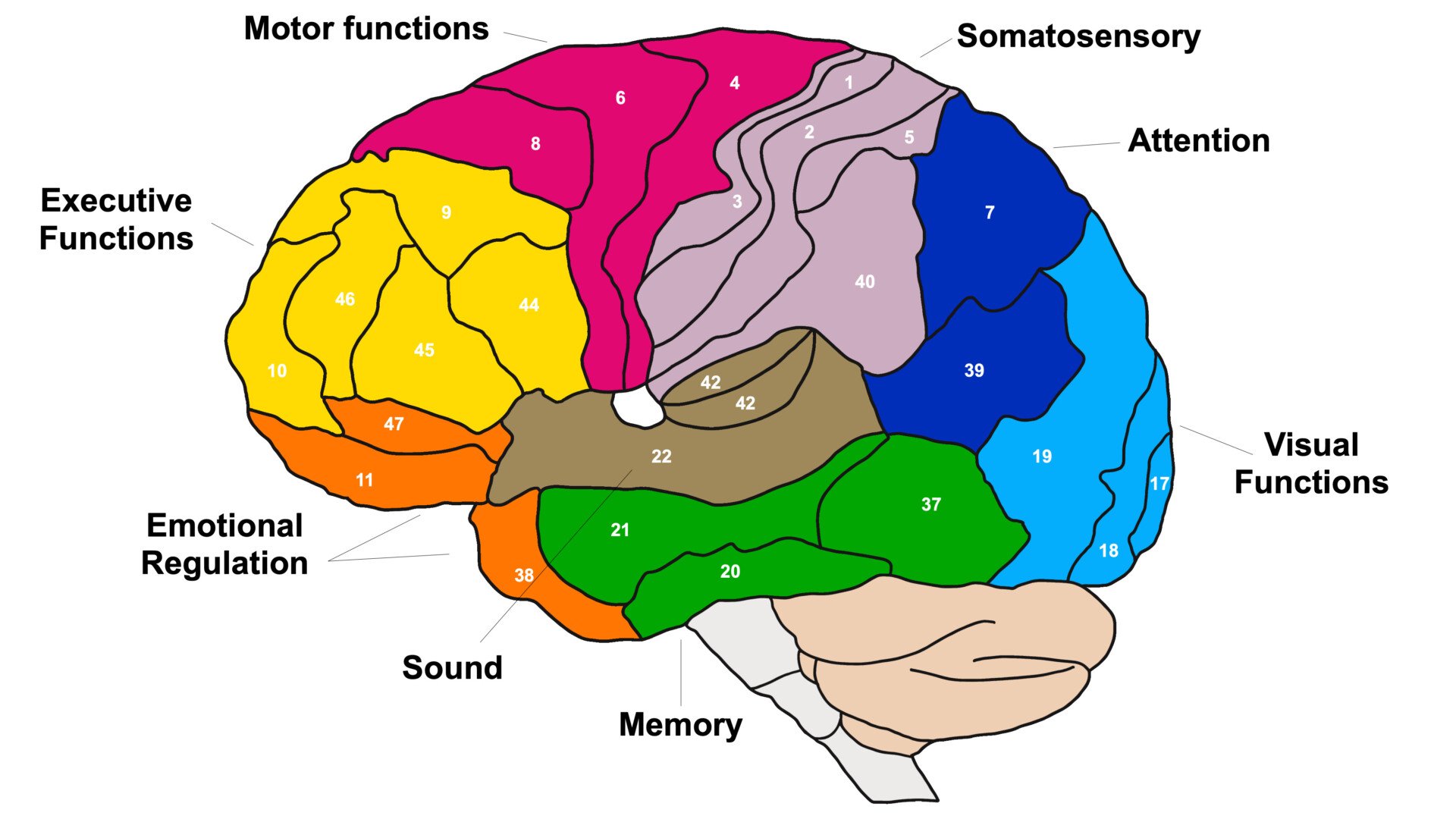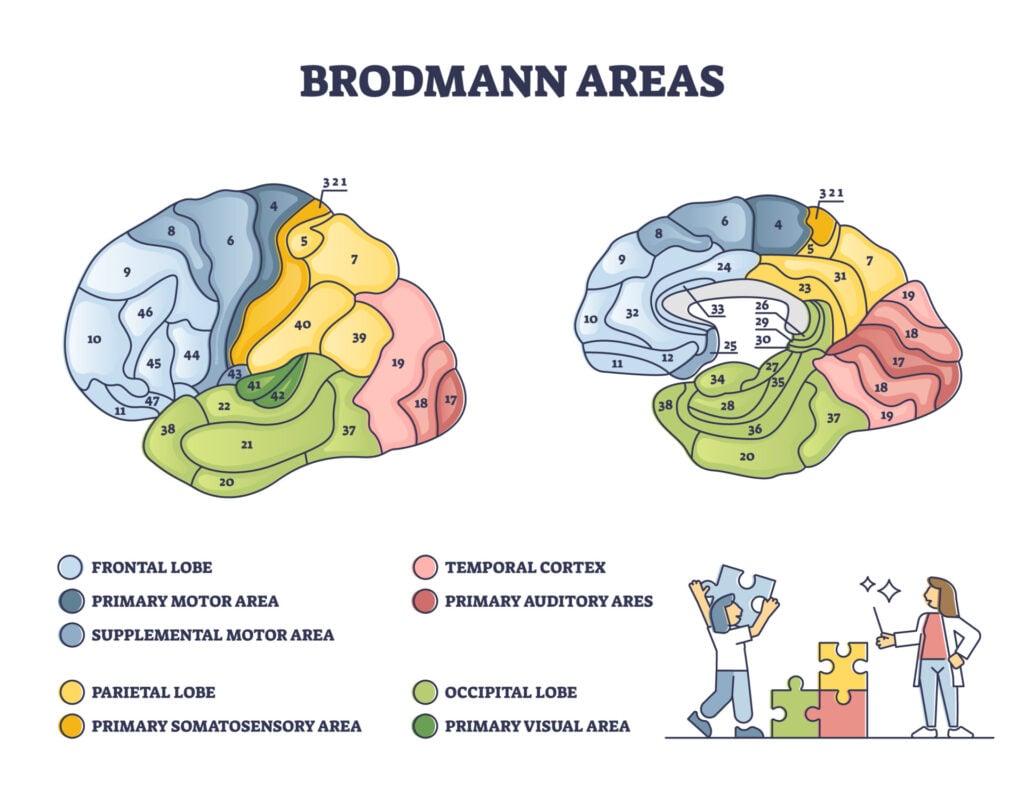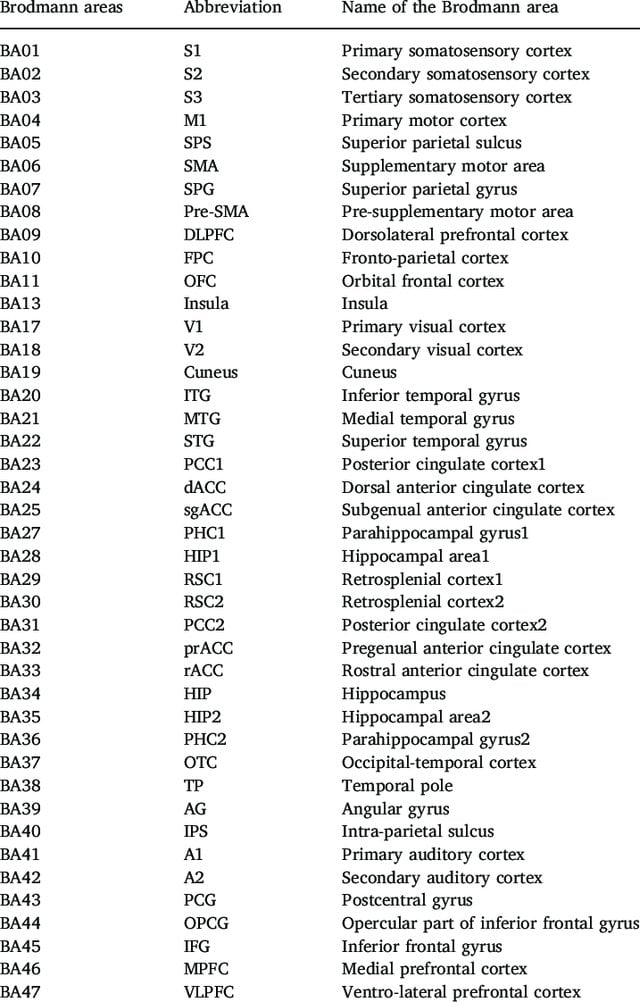On This Page:
Different parts of the cerebral cortex are involved in cognitive and behavioral functions.
The Brodmann areas are a way of mapping the cortex and its distinguished functions, pioneered by Korbinian Brodmann, from which the areas are named.
Through using Brodmann’s areas, the cortex of the brain can be divided into 52 areas which are numbered sequentially. These areas are distinguished by microscopic anatomy through the shapes and types of cells and their connections.
Despite controversy about how precise these areas are located, Brodmann’s areas are still widely used today. However, some areas have since been subdivided or are only present in nonhuman primates.

Brodmann Areas, named after German neurologist Korbinian Brodmann, are a system for mapping and categorizing regions of the human cerebral cortex based on their distinct cellular architecture and functions. These numbered areas, which range from 1 to 52, provide a structural framework for understanding different brain functions, such as sensory processing, motor control, and higher cognitive processes, contributing to our knowledge of brain organization and function.
History of Brodmann Areas
Korbinian Brodmann (1868-1918) was a German neurologist who published research on cortical cytoarchitectonics in many species, including humans. This publication contained what was believed to be the first map of the cerebral cortex based on variations in neural structure.
Brodmann (1909) detailedly studied the cortex, observing how its layers, tissues, neurons, and other cells varied in structure and size.
He identified and numbered different areas of the brains of many mammals, ending some of the considerable confusion in naming parts of the cortex that existed at the time.
Before Brodmann’s research, some areas of the brain were beginning to be identified, such as Broca and Wernicke’s areas. These areas were identified after damage was discovered in these areas, after language deficits were noticed in these individuals.
Brodmann’s mapping of the brain takes this further and details all the functional areas of the cortex based on gross anatomical features and cortical micro-structures.
Brodmann’s areas have been widely discussed, debated, and refined throughout the years and remain the most widely known and most frequently used mapping of the cortex.
Important areas
Brodmann areas 1, 2, and 3 – Primary somatosensory cortex
The primary somatosensory cortex is responsible for processing sensations of the body. Receptors throughout the body pick up these sensations, responsible for detecting touch, pain, temperature, and localization of touch.
This region is also important for skilled and coordinated movements as well as motor learning.
Brodmann area 4 – Primary motor cortex
The primary motor cortex is essential for initiating motor movements as well as coordinating these movements. Each area of the motor cortex corresponds precisely to specific body parts on the contralateral side of the body.
E.g., in order to move the left leg, part of the primary motor cortex in the right hemisphere is stimulated.
Brodmann area 9 – Dorsolateral prefrontal cortex
The dorsolateral prefrontal cortex is located in the frontal lobe and is essential for ‘higher’ cognitive functions such as working memory, planning, abstract reasoning, motor planning, and organization.
Due to its importance for many executive functions, this area has multiple connections between cortical and subcortical areas of the brain.
Brodmann area 17 – Primary visual cortex
The primary visual cortex, located in the occipital lobes, is a structure essential to the processing of visual stimuli.
This area is the most widely studied visual area of the brain and is highly specialized for the processing of static and moving objects, as well as being good at recognizing patterns.
Brodmann area 21 – Middle temporal gyrus
The middle temporal gyrus is one of the main gyri (ridge) on the surface of the temporal lobes.
This area is believed to be involved in functions such as sound recognition and semantic retrieval, as well as semantic memory, language processing, and processing of verbal and mental arithmetic.
Brodmann area 22 – Superior temporal gyrus
The superior temporal gyrus is also located within the temporal lobes and has a role in both verbal and non-verbal communication.
This area has been found to be important for contributing to the processing of both object and space-related information, and processing non-verbal social cues.
As well as this, this area is involved in auditory short-term memory and the production of speech. Wernicke’s area is also considered to be located in this area, a region associated with language comprehension and the production of language.
Brodmann areas 23, 24, 28 and 33 – Cingulate gyrus
The cingulate gyrus is a large arched fold above the corpus callosum. It is an important part of the limbic system, helping to regulate emotions and pain.
This gyrus is believed to directly drive the body’s conscious response to unpleasant experiences, as well as being involved in fear and avoidance of negative stimuli. As the cingulate gyrus learns to avoid negative consequences, it also plays a role in memory.
Brodmann areas 44 and 45 – Broca’s area
Located within the frontal lobes, Broca’s area is an essential region for the production of language. This area is able to put together the elements of language, select information from a variety of sources and help to produce information about the motor movements required for spoken and written language.
Similarly, Broca’s area can help control mechanisms for syntactic processing and construct complex sentences and speech patterns.
Broadman Areas Location and Function

- Brodmann areas 1, 2 & 3 : Primary somatosensory Cortex (postcentral gyrus) – responsible for processing somatic sensations.
- Brodmann area 4 : Primary Motor Cortex (precentral gyrus) – involved in the execution of movement.
- Brodmann area 5 : Somatosensory Association Cortex (superior parietal lobule) – an area for sensory input.
- Brodmann area 6 : Premotor Cortex and Supplementary Motor Cortex – helps to control and plan movements.
- Brodmann area 7 : Somatosensory Association Cortex – an area for sensory input.
- Brodmann area 8 : Frontal eye fields – role in the control of visual attention and eye movements.
- Brodmann area 9 : Dorsolateral prefrontal cortex – involved in cognitive functions such as working memory, attention, and executive function.
- Brodmann area 10 : Anterior prefrontal cortex – higher cognitive functions such as task management and planning.
- Brodmann area 11 & 12 : Orbitofrontal Area (orbital gyri, gyrus rectus, rostral gyrus and part of superior frontal gyrus) – receives information about the sight of objects as well as the reward value of taste.
- Brodmann area 13 & 16 : Insular Cortex – sensory processing, decision-making, and motor control.
- Brodmann area 17 : Primary Visual Cortex (V1) – interpreting and processing visual information received from the eyes.
- Brodmann area 18 : Secondary Visual Cortex (V2) – – receives visual information for further analysis.
- Brodmann area 19 : Associative Visual Cortex (V3, V4 & V5) – complex processing of visual information.
- Brodmann area 20 : Inferior Temporal Gyrus – processes visual information in the field of vision and is involved with memory.
- Brodmann area 21 : Middle Temporal Gyrus – semantic memory processing, visual perception, and language processing.
- Brodmann area 22 : Superior Temporal Gyrus (including Wernicke’s Area) – important for processing sounds and comprehension of speech.
- Brodmann area 23, 24, 28 to 33 : Cingulate Gyrus – a part of the limbic system which is involved in processing emotions and behavior regulation.
- Brodmann area 25 : Subgenual Area – a limbic area rich in serotonin transporters which works with the other areas of the limbic system.
- Brodmann area 26 : Ectosplenial portion of the retrosplenial region of the cerebral cortex – related to motor learning.
- Brodmann area 27 : Piriform cortex – related to the sense of smell.
- Brodmann area 29 : Retrosplenial cingulate cortex – related to episodic memory and navigation.
- Brodmann area 30 : Part of the cingulate cortex – an interface between emotional regulation, sensing and action.
- Brodmann area 31 : Dorsal posterior cingulate cortex – a central node of the default mode network (DMN), a set of brain structures with strong associations for activity during many cognitive tasks.
- Brodmann area 32 : Dorsal anterior cingulate cortex – processing the detection and appraisal of social processes.
- Brodmann area 34 : Dorsal Entorhinal Cortex – involved in working memory.
- Brodmann area 35 & 36 : Dorsal entorhinal cortex – involved in working memory.
Area 35 & 36 – Perirhinal cortex and ectorhinal area – involved in working memory. - Brodmann area 37 : Fusiform gyrus – involved in higher-level visual processing.
- Brodmann area 38 : Temporal pole – high-level visual area involved in visual cognition, face recognition, and visual memory.
- Brodmann area 39 : Angular gyrus – related to language and number processing, spatial cognition, memory retrieval, and attention.
- Brodmann area 40 : Supramarginal gyrus – a role in phonological processing and emotional responses.
- Brodmann area 41 & 42 : Primary auditory cortex (Heschl gyrus) – first relay station of auditory information in the cortex.
- Brodmann area 43 : Primary gustatory cortex – responsible for the perception of taste.
- Brodmann area 44 : Part of Broca area (pars opercularis, part of the inferior frontal gyrus) – associated with speech production and articulation.
- Brodmann area 45 : Part of Broca area (pars triangularis, part of the class=”internal”> inferior frontal gyrus) – associated with speech production and articulation.
- Brodmann area 46 : Dorsolateral Prefrontal Cortex – involved in cognitive functions such as working memory, attention, and executive function.
- Brodmann area 47 : Pars orbitalis, part of the inferior frontal gyrus – role in the processing of language.
- Brodmann area 48 : Retrosubicular area – processing of emotions, encoding, and navigation.
- Brodmann area 52 : Parainsular area related to attention and salience processing.
Brodmann Areas List
References
Brodmann K. 1909. Vergleichende Lokalisationslehre der Grobhirnrinde in ihren Prinzipien dargestellt auf Grund des Zellenbaues. Leipzig: J.A. Barth
Carter, R. (2019). The Human Brain Book: An Illustrated Guide to its Structure, Function, and Disorders (3rd ed). DK.
Ferng, A. (2021, May 31). Brodmann areas. Kenhub. https://www.kenhub.com/en/library/anatomy/brodmann-areas
Hacking, C. Gaillard et al., (n.d.). Brodmann areas. Radiopaedia. Retrieved August 6, 2021, from: https://radiopaedia.org/articles/brodmann-areas?lang=gb


